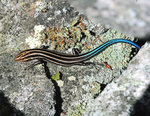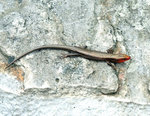On a July day in 2017, I was walking on a trail in state game lands in northern Pike County when I spotted movement on the trunk of a fallen tree. It moved quickly and in short spurts; the movement …
Stay informed about your community and support local independent journalism.
Subscribe to The River Reporter today. click here
This item is available in full to subscribers.
Please log in to continue |


On a July day in 2017, I was walking on a trail in state game lands in northern Pike County when I spotted movement on the trunk of a fallen tree. It moved quickly and in short spurts; the movement did not seem to be characteristic of any animal I have previously seen in the region. I got a little closer and I could see it was a lizard about six inches long with stripes running down its back and long tail. I was able to capture a few images of this stranger before it dashed out of sight. I thought that it might be a five-lined skink, but it moved quickly and I wasn’t close enough, so I had to look at my pictures to confirm this. I found out later that this was the first documented appearance of this species in Pike County, PA.
The common five-lined skink does occur in Pennsylvania but in the Eastern part of the state; it occurs in Monroe County and south. Five-lined skinks also occur in southern NY counties. There are no documented sightings of this species in Sullivan County as of yet, but there were unconfirmed reports of sightings in past years. As of now, the count that is maintained by the Pennsylvania Amphibian and Reptile Survey (PARS) stands at two sightings (www.bit.ly/RRpars).
Five-lined skinks can be somewhat striking to see depending on sex, age and the time of year. This lizard’s name comes from the five stripes that run along the length of its body. Younger animals of this species have more distinct stripes that fade, becoming less distinct as they reach maturity. Juvenile five-lined skinks also have azure blue tails that make them easy to see. Speaking of tails, if a predator grabs a skink’s tail, it will likely break off, leaving the predator with a still wriggling tail while the skink makes its escape.
It is breeding season for five-lined skinks right now, and that means they may be easier to spot. Last week, at least a half dozen were spotted in a site during a timber rattlesnake survey. If there are any more to be spotted in our region, this is likely the time to spot them. Skinks prefer open areas with log or rock cover, such as powerline right of ways or areas next to roads. They tend to scramble for cover if we get too close, but if you are patient and be still, they may come back out into the open.
Comments
No comments on this item Please log in to comment by clicking here